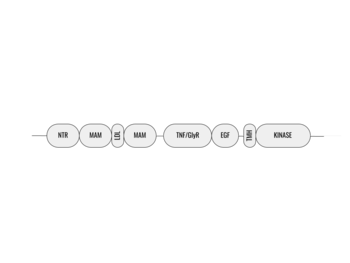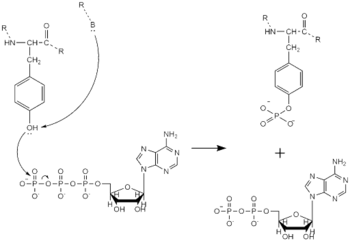Sandbox Reserved 1704
From Proteopedia
| This Sandbox is Reserved from February 28 through September 1, 2022 for use in the course CH462 Biochemistry II taught by R. Jeremy Johnson at the Butler University, Indianapolis, USA. This reservation includes Sandbox Reserved 1700 through Sandbox Reserved 1729. |
To get started:
More help: Help:Editing |
Contents |
Anaplastic Lymphoma Kinase (ALK)
Introduction
Anaplastic lymphoma kinase is a receptor tyrosine kinase (RTK) that is important in regulating functions within the central nervous system [1]. The route to the discovery of the structure of this protein was rather complex, spanning almost 20 years with the kinase domain being discovered in 1994, the full protein structure in 1997, and the ligand structures discovered in 2014. These structures were found using cryo-electron microscopy,nuclear magnetic resonance, and X-ray crystallography. Anaplastic lymphoma kinase is a proto-oncogene with mutations associated with various types of cancers, including non-small-cell lung cancer, anaplastic large cell lymphoma, squamous cell carcinoma, and inflammatory myofibroblastic cancer [2].
General Structure
Anaplastic lymphoma kinase is a homodimer, each monomer consisting of seven domains and two regions [3]. These domains and regions are as follows: N-terminal region (NTR), two meprin–A-5 protein–receptor protein tyrosine phosphatase μ domains (MAM), low density lipoprotein receptor class A domain (LDL), tumor necrosis factor receptor-like domain (TNF), glycine rich region (GlyR), epidermal growth factor receptor-like domain (EGF), transmembrane α-helix (TMH), kinase domain [1]. The structures of the N-terminal region, MAM, and LDL have not been determined. The glycine rich region is a part of the TNF domain. Only the TNF, GlyR, and EGF portions of ALK are required for ligand binding. All portions of anaplastic lymphoma kinase are located in the extracellular domain except for the transmembrane α-helix which is in the transmembrane region and the kinase domain that is located in the intracellular domain.Ligand Binding
The ligands utilized by anaplastic lymphoma kinase are monomeric FAM150 and dimeric AUG. It's biologically preferred ligand is dimeric AUG. The binding of ALK to it's ligand causes results in homodimerization and a conformational change. Prior to the ligand binding to anaplastic lymphoma kinase, the extracellular domain is oriented sticking up perpendicularly to the plasma membrane. Once the ligand is bound, ALK undergoes a conformational change and folds over so that the positively charged residues on the portion of the protein previously sticking up perpendicularly is now interacting to the negatively charged residues on the plasma membrane. Once the ligand is bound and the conformational change has occurred, the kinase domain is auto-activated in which the domains use the tyrosine phosphorylation mechanism to phosphorylate the tyrosine residue on the opposite monomer.
Tyrosine Phosphorylation Mechanism
Dimerization of anaplastic lymphoma kinase activates the kinase domains of each monomer. Next, the kinase domains phosphorylate the tyrosine residues of the opposite monomer using ATP. These phosphorylated tyrosine residues recruit signal proteins through phosphorylation. These signal proteins begin a signaling cascade through utilizing various signal pathways. These pathways signal for cell proliferation and survival (ex: begin transcription).Applications
Anaplastic lymphoma kinase's involvement as a proto-oncogene in various types of cancers has made it a target for drug therapies for these types of cancers [4]. One therapeutic medication that has been increasingly used with high levels of success is Crizotinib. This medication was approved by the FDA in January of 2021 for the treatment of pediatric/young adult ALK-positive anaplastic large cell lymphoma. The treatment has an overall response rate of 90%. Crizotinib works by binding to the ATP binding site of the kinase domain [5]. Crizotinib binds preferentially to ATP in this region and therefore can effectively block the binding of ATP [5]. With the binding of ATP being blocked, the intercellular signaling cascade cannot begin which works to prevent the cancer from growing and spreading .
|
References
- ↑ 1.0 1.1 Reshetnyak AV, Rossi P, Myasnikov AG, Sowaileh M, Mohanty J, Nourse A, Miller DJ, Lax I, Schlessinger J, Kalodimos CG. Mechanism for the activation of the anaplastic lymphoma kinase receptor. Nature. 2021 Dec;600(7887):153-157. doi: 10.1038/s41586-021-04140-8. Epub 2021, Nov 24. PMID:34819673 doi:http://dx.doi.org/10.1038/s41586-021-04140-8
- ↑ Palmer RH, Vernersson E, Grabbe C, Hallberg B. Anaplastic lymphoma kinase: signalling in development and disease. Biochem J. 2009 May 27;420(3):345-61. doi: 10.1042/BJ20090387. PMID:19459784 doi:http://dx.doi.org/10.1042/BJ20090387
- ↑ Li T, Stayrook SE, Tsutsui Y, Zhang J, Wang Y, Li H, Proffitt A, Krimmer SG, Ahmed M, Belliveau O, Walker IX, Mudumbi KC, Suzuki Y, Lax I, Alvarado D, Lemmon MA, Schlessinger J, Klein DE. Structural basis for ligand reception by anaplastic lymphoma kinase. Nature. 2021 Dec;600(7887):148-152. doi: 10.1038/s41586-021-04141-7. Epub 2021, Nov 24. PMID:34819665 doi:http://dx.doi.org/10.1038/s41586-021-04141-7
- ↑ Lewis RT, Bode CM, Choquette D, Potashman M, Romero K, Stellwagen JC, Teffera Y, Moore E, Whittington DA, Chen H, Epstein LF, Emkey R, Andrews PS, Yu V, Saffran DC, Xu M, Drew AE, Merkel P, Szilvassy S, Brake RL. The discovery and optimization of a novel class of potent, selective and orally bioavailable Anaplastic Lymphoma Kinase (ALK) Inhibitors with potential utility for the treatment of cancer. J Med Chem. 2012 Jun 26. PMID:22734674 doi:10.1021/jm3005866
- ↑ 5.0 5.1 Sahu A, Prabhash K, Noronha V, Joshi A, Desai S. Crizotinib: A comprehensive review. South Asian J Cancer. 2013 Apr;2(2):91-7. doi: 10.4103/2278-330X.110506. PMID:24455567 doi:http://dx.doi.org/10.4103/2278-330X.110506
Student Contributors
- Kaylin Todor
- Rebekah White



